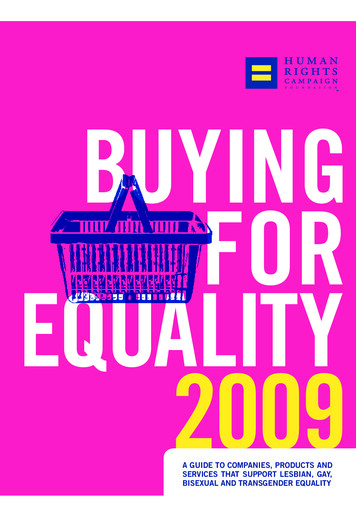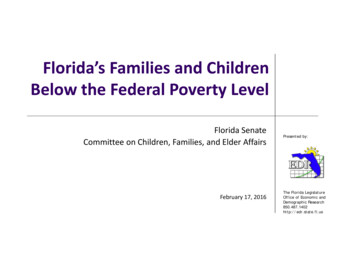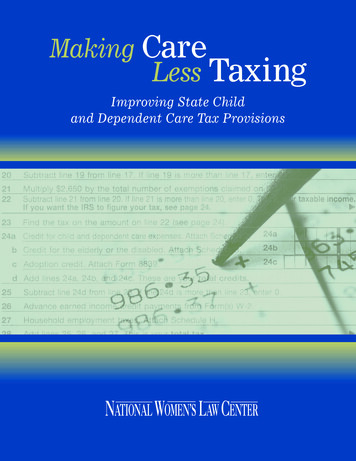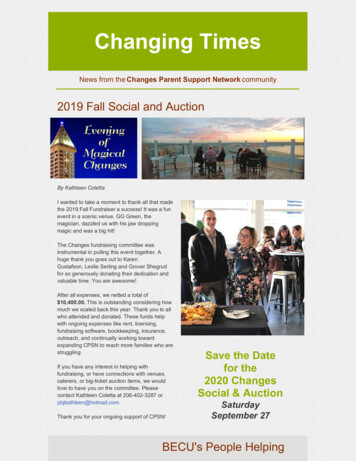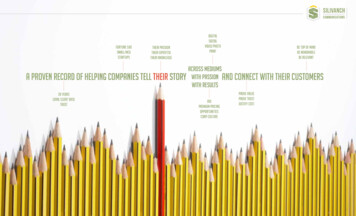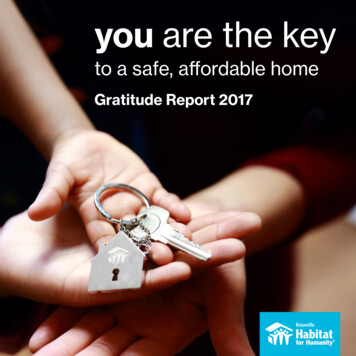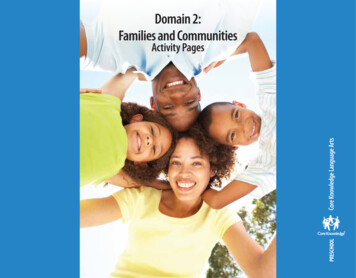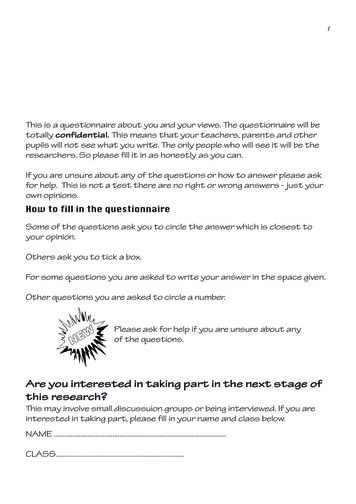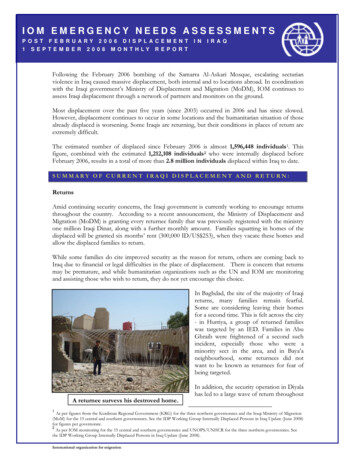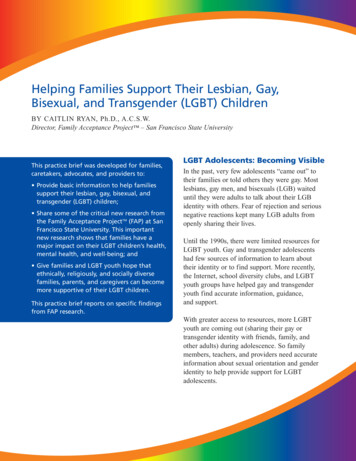
Transcription
Helping Families Support Their Lesbian, Gay,Bisexual, and Transgender (LGBT) ChildrenBY CAITLIN RYAN, Ph.D., A.C.S.W.Director, Family Acceptance Project – San Francisco State UniversityThis practice brief was developed for families,caretakers, advocates, and providers to: Provide basic information to help familiessupport their lesbian, gay, bisexual, andtransgender (LGBT) children; Share some of the critical new research fromthe Family Acceptance ProjectTM (FAP) at SanFrancisco State University. This importantnew research shows that families have amajor impact on their LGBT children’s health,mental health, and well-being; and Give families and LGBT youth hope thatethnically, religiously, and socially diversefamilies, parents, and caregivers can becomemore supportive of their LGBT children.This practice brief reports on specific findingsfrom FAP research.LGBT Adolescents: Becoming VisibleIn the past, very few adolescents “came out” totheir families or told others they were gay. Mostlesbians, gay men, and bisexuals (LGB) waiteduntil they were adults to talk about their LGBidentity with others. Fear of rejection and seriousnegative reactions kept many LGB adults fromopenly sharing their lives.Until the 1990s, there were limited resources forLGBT youth. Gay and transgender adolescentshad few sources of information to learn abouttheir identity or to find support. More recently,the Internet, school diversity clubs, and LGBTyouth groups have helped gay and transgenderyouth find accurate information, guidance,and support.With greater access to resources, more LGBTyouth are coming out (sharing their gay ortransgender identity with friends, family, andother adults) during adolescence. So familymembers, teachers, and providers need accurateinformation about sexual orientation and genderidentity to help provide support for LGBTadolescents.
Require Respect in the Family for Your LGBT Child“We always went to family events. But after Terry came out, Iwas worried about what the other family members might sayto her or how they might treat her.“So I told them, ‘Our family events are very important to us.We have always come. We want our daughter to becomfortable. And we want her to come with us. So I wantyou to know that we won’t be able to come anymore—as afamily—if you can’t treat her with respect.’“CHARLENE, MOTHER OF A 15-YEAR OLD LESBIAN DAUGHTERResearch on adolescents over the past 20 years showsthat sexual orientation—a person’s emotionalconnection and attraction to another person—develops early. In fact, research shows that both gayand straight children have their first “crush “ orattraction to another person at around age 10.Homosexuality and bisexuality are part of normalsexual identity. No one knows why some people aregay or bisexual and others are heterosexual. But weknow that no one, including parents, can “make”someone gay. Adolescents are much more likely to beopen about their gay or transgender identity whenthey are not afraid of rejection, ridicule, or negativereactions from family and friends.Exposing the MythsThere are still many myths about sexual orientation.Families and providers often believe that youngpeople have to be adults before they can know theyare gay. Many assume that being gay is a “phase” thatyouth will grow out of as they get older. Some thinkthat teens may decide to be gay if they have a gayfriend, read about homosexuality, or hear about gaypeople from others. These myths are very commonand they are also incorrect.Today, adolescents have much wider access toaccurate information about sexual orientation andincreasing information about gender identity.Accurate information helps them understand feelings2they have had since childhood. And a wide range ofservices for LGBT youth helps many find peer andcommunity support.Adolescents in our research for the FamilyAcceptance ProjectTM (FAP) said they were attractedto another person of the same gender at about age 10.Some knew they were gay at age 7 or 9. Overall, theyidentified as lesbian, gay, or bisexual, on average, atage 13.4. Their families learned about their LGBidentity about a year later.Research on supporting both children’s genderidentity and transgender adolescents is very limited.Most providers have had little training or guidance onhow to support children who feel like their innersense of being male or female does not match theirphysical body. Children develop gender identity—adeep sense of being male or female—at early ages.They express clear gender choices for clothes, toys,and personal items. And they begin to express genderidentity at about ages 2-3.Children and adolescents who do not look or behavethe way that girls and boys are expected to behave bytheir families and by society are often ridiculed byothers. Their behavior may also be called gendervariant or gender non-conforming. Many parents areashamed or embarrassed by their children’s gendernon-conforming behavior. They often fear that thesechildren will be hurt by others. And they neededucation and accurate information to support theirchild’s emerging gender identity.Adolescents who are gender non-conforming or whoidentify as transgender also have more access toinformation about gender expression and identitythrough LGBT community groups and onlineresources. Such groups and resources help themunderstand their gender identity at younger ages thanolder transgender adults who typically came out asHELPING FAMILIES SUPPORT LGBT CHILDREN FALL/WINTER 2009
Support Your Child’s LGBT IdentityEven When You Feel Uncomfortable“Shondra started to get real depressed in 5th grade. She didn’ttalk much anymore, and she spent a lot of time in her room.“When she was little, she didn’t like to wear a dress, but shewas sweet and would let me dress her up. But by the time shewas 9, she started to hate wearing dresses.“And now, well, my momma and I didn’t know what waswrong. I thought she was being willful and disobedient. Thenthe counselor at school asked us to come in and talk with her.She said that Shondra had another name at school. She askedthe other students to call her Darnell and she dressed like aboy, with a boy’s name.“The school counselor told us about transgender. We neverheard of such a thing. She thought that Shondra wastransgender and she gave us the name of another counselor.They told us what Shondra, I mean, Darnell was feeling whenwe tried to dress her up and be a certain way. They said thatfor our child, the way we were acting felt like we wererejecting her. They showed us that children like this get verydepressed, and they are at very high risk for suicide whentheir family tries to make them act like a girl.“We were shocked. We had no idea. So we got our child helpand he’s much happier now.”TYRA AND SHIRLENE, MOTHER AND GRANDMOTHEROF A 12-YEAR-OLD TRANSGENDER YOUTHadults. Adolescents in our research for FAP whoidentify as transgender came out as transgender, onaverage, at age 16.Impact of Family Reactionson LGBT ChildrenUntil recently, little was known about how familiesreact when an LGBT young person comes out duringadolescence. And even less was known about howfamily reactions affect an LGBT adolescent’s healthand mental health.Groundbreaking new research from FAP shows thatfamilies and caregivers have a major impact on theirLGBT children’s risk and well-being.1,2 FAPresearchers identified more than 100 behaviors thatfamilies and caregivers use to react to their LGBTchildren’s identity. About half of these behaviors areaccepting and half are rejecting. FAP researchersmeasured each of these behaviors to show howfamily reactions affect an LGBT young person’srisk and well-being.Conflict and RejectionFAP researchers found that families who areconflicted about their children’s LGBT identitybelieve that the best way to help their childrensurvive and thrive in the world is to help them fit inwith their heterosexual peers. So when these familiesblock access to their child’s gay friends or LGBTresources, they are acting out of care and concern.They believe their actions will help their gay ortransgender child have a good life. But adolescentswho feel like their parents want to change who theyare think their parents don’t love them or even hatethem. Lack of communication and misunderstandingbetween parents and their LGBT children increasesfamily conflict. These problems with communicationand lack of understanding about sexual orientationand gender identity can lead to fighting and familydisruption that can result in an LGBT adolescentbeing removed from or forced out of the home. ManyLGBT youth are placed in foster care, or end up injuvenile detention or on the streets, because of familyconflict related to their LGBT identity.3 These factorsincrease their risk for abuse and for serious healthand mental health problems.1Ryan, C. (2009). Supportive families, healthy children: Helping families with lesbian, gay, bisexual and transgender children. San Francisco, CA:Marian Wright Edelman Institute, San Francisco State University.2Ryan, C., Huebner, D., Diaz, R. M., & Sanchez, J. (2009). Family rejection as a predictor of negative health outcomes in white and Latino lesbian,gay and bisexual young adults. Pediatrics, 123(1): 346-352.3Wilbur, S., Ryan, C., & Marksamer, J. (2006). Best practices guidelines: Serving LGBT youth in out-of-home care. Washington, DC: Child WelfareLeague of America (CWLA).HELPING FAMILIES SUPPORT LGBT CHILDREN FALL/WINTER 20093
Connect Your Child With LGBT Resources“We found out our son was gay when he was in middleschool. I reached out to get as much information as I could.We took him to gay events so that he could see other gaypeople leading regular lives.“Later, we met older Asian gay men in their 50s and 60s whospoke with great pain about having to live a lie, and neverbeing able to be honest about who they were with theirparents. One finally told his mother he was gay and she said,‘This is the worst day of my life.’“My wife and I support our son 110%. And this means thatwe have to speak out and tell other parents that we need tobe proud of our gay kids.”JOHN, FATHER OF A 15-YEAR-OLD GAY SONResearch from FAP shows that family rejection has aserious impact on LGBT young people’s health andmental health. LGBT young people who were rejectedby their families because of their identity have muchlower self-esteem and have fewer people they can turnto for help. They are also more isolated and have lesssupport than those who were accepted by their families.LGBT teens who are highly rejected by their parentsand caregivers are at very high risk for health andmental health problems when they become youngadults. They have poorer health than LGBT youngLIFETIME SUICIDE ATTEMPTSpeople who are not rejected by their families. Theyhave more problems with drug use. They feel morehopeless and are much less likely to protect themselvesfrom HIV or sexually transmitted diseases (STDs).And this behavior puts them at higher risk for HIVand AIDS.Compared with LGBT young people who were notrejected or were only a little rejected by their parentsand caregivers because of their gay or transgenderidentity, highly rejected LGBT young people were: More than 8 times as likely to have attempted suicide; Nearly 6 times as likely to report high levelsof depression; More than 3 times as likely to use illegal drugs; and More than 3 times as likely to be at high risk forHIV and STDs.Many LGBT youth and those who question theiridentity feel like they have to hide who they are toavoid being rejected. Many hide so that they won’thurt their parents and other family members whobelieve that being gay is wrong or sinful. But hidinghas a cost. It undermines an LGBT adolescent’sself-esteem and sense of self-worth.(1 or more times)This drawing shows the serious impact of high levels of familyrejection on LGBT young people, ages 21-25. These parents triedto prevent their children from being gay or transgender or toldthem they were disappointed or ashamed at having a gay ortransgender child. And they disapproved of their LGBT child inother ways. (See page 5 for a list of some rejecting behaviors thatare very harmful for LGBT EVEL OF FAMILY REJECTIONRyan, Family Acceptance Project, 20094In this drawing, LGBT young adults who had many experiences ofrejection during adolescence were at much higher risk for trying tocommit suicide than those in families who were only a little rejectingor were not at all rejecting (low rejection). LGBT youth from highlyrejecting families were more than 8 times as likely to try to taketheir own lives by the time they were young adults. In families thatwere moderately rejecting (had some negative reactions to theirLGBT child but also had some positive reactions), those youngpeople were only about twice as likely to try to kill themselves.HELPING FAMILIES SUPPORT LGBT CHILDREN FALL/WINTER 2009
ILLEGAL DRUG USELowRejectionModerateRejectionRISK FOR HIV INFECTIONHighRejectionLEVEL OF FAMILY nLEVEL OF FAMILY REJECTIONRyan, Family Acceptance Project, 2009Ryan, Family Acceptance Project, 2009As with risk for suicide, gay and transgender young peoplewith high levels of family rejection were more than 3 times aslikely to use illegal drugs compared with LGBT young peoplefrom families with little or no rejection. Their use of illegaldrugs was cut in half when families were moderately rejecting.LGBT young people from highly rejecting families were morethan 3 times as likely to be at high risk for HIV and sexuallytransmitted diseases as young people from families who werenot rejecting. Their risk was cut in half when families weremoderately rejecting.Being valued by their parents and family helpschildren learn to value and care about themselves.But hearing that they are bad or sinful sends a deepmessage that they are not a good person. And hearingthis negative message affects their ability to lovethemselves and care for themselves. It increases riskybehaviors, such as risk for HIV or substance abuse.It also affects their ability to plan for the future,including their ability to have career or vocationalplans. And it makes them less likely to want to have afamily or to be parents themselves.Some Family Behaviors that Increase Your LGBT Child’s Risk forHealth and Mental Health ProblemsBEHAVIORS TO AVOID Hitting, slapping or physically hurting your child becauseof their LGBT identity Pressuring your child to be more (or less) masculineor feminine Verbal harassment or name-calling because of yourchild’s LGBT identity Telling your child that God will punish them becausethey are gay Excluding LGBT youth from family events andfamily activities Telling your child that you are ashamed of them or thathow they look or act will shame the family Blocking access to LGBT friends, events, and resources Making your child keep their LGBT identity a secret inthe family and not letting them talk about their identitywith others Blaming your child when they are discriminated againstbecause of their LGBT identity Caitlin Ryan, Family Acceptance Project, 2009. Reprinted with permission.HELPING FAMILIES SUPPORT LGBT CHILDREN FALL/WINTER 20095
Uncertainty and ConcernMany parents feel uncertain when they learn thattheir child is gay. They are unsure how to react. Andthey don’t know how to support their child. They loveand want to help their LGBT child. At the same time,however, they don’t want to encourage their child’sgay or transgender identity. And they don’t want topush their child away.Parents and caregivers often fear that others may tryto hurt their gay or transgender child. So fearmotivates many parents and family members to try toSome Family Behaviors that Reduce YourLGBT Child’s Risk for Health and MentalHealth Problems & Help Promote TheirWell-BeingBEHAVIORS THAT HELP Talk with your child or foster child about their LGBTidentity. Express affection when your child tells you or whenyou learn that your child is LGBT. Support your child’s LGBT identity even though youmay feel uncomfortable. Advocate for your child when he or she is mistreatedbecause of their LGBT identity. Require that other family members respect yourLGBT child. Bring your child to LGBT organizations or events. Connect your child with an LGBT adult role model toshow them options for the future. Work to make your congregation supportive of LGBTmembers, or find a supportive faith community thatwelcomes your family and LGBT child. Welcome your child’s LGBT friends & partner to yourhome and to family events and activities. Support your child’s gender expression. Believe your child can have a happy future as anLGBT adult.protect their LGBT children by reacting negatively totheir gay or transgender identity. For example, theysay: “Tone it down.” “Do you have to wear thoseclothes?” “Can’t you wait until you graduate to tellothers you’re gay?” Youth often hear these commentsas rejection, but too often parents use them to masktheir anxiety and fear of what can happen to theirchild in a hostile world.Families are motivated to learn how to support theirgay or transgender children when they realize thattheir words and actions have a powerful impact ontheir LGBT children’s survival and well-being.Parents are shocked to learn that how they react totheir LGBT children can increase these children’s riskfor suicide, HIV infection, and other health problems.But they are relieved to learn that behaviors liketalking with their gay children about their identity,and expressing affection for their gay or transgenderchildren, can help protect against health risks. Thesesupportive behaviors can also help promote theirchildren’s well-being. (Some important supportivebehaviors to help families protect their LGBTchildren against risk and to promote their well-beingare included in the box on this page.)Family AcceptanceFAP researchers also studied families who openlyaccept their children’s gay or transgender identity.Accepting parents and foster parents express supportfor their LGBT children in many ways. They tell theirchildren they love them when they learn about theirchild’s LGBT identity. They require that other familymembers respect their LGBT child. They stand up fortheir LGBT child when their child is mistreated orharassed by others. And they work to make their ownreligious institutions more supportive of LGBTmembers. Or they find supportive congregations andfaith communities that welcome their family andLGBT child. Caitlin Ryan, Family Acceptance Project, 2009. Reprinted with permission.6HELPING FAMILIES SUPPORT LGBT CHILDREN FALL/WINTER 2009
FAP researchers found that accepting families comefrom all ethnic and class backgrounds, includingfamilies with no formal education or income. FAPresearchers identified and measured more than50 behaviors that parents and caregivers used tosupport their child’s LGBT identity.Families can support their child’s LGBT identity evenwhen they feel uncomfortable or when they thinkbeing gay or transgender is wrong. In fact, over time,most parents, families, and caregivers become lessrejecting and more supportive of their LGBT children.Education, accurate information, and peer supporthelp parents and families deal with their concernsand learn how to help their children and themselves.LGBT young adults whose parents and foster parentssupport them have better overall health, and mentalhealth. They also have higher self-esteem. And theyare much less likely to be depressed, to use illegaldrugs, or to think about killing themselves or toattempt suicide.LGBT youth who are accepted by their families aremuch more likely to believe they will have a good lifeand will become a happy, productive adult. In familiesthat are not at all accepting of their adolescent’s gayor transgender identity, only about 1 in 3 youngpeople believes they will have a good life as a gayadult. But in families that are extremely accepting,nearly all LGBT young people believe they can havea happy, productive life as an LGBT adult.Supportive parents and families can help build selfesteem and a positive sense of self in gender nonconforming children and teens. They can help themlearn positive coping skills and how to deal withridicule and discrimination from others. Gendervariant youth who are supported by their families areat lower risk for health and mental health problems asyoung adults. They have greater well-being and arebetter adjusted than those whose parents do notsupport or try to change their gender expression.HELPING FAMILIES SUPPORT LGBT CHILDREN FALL/WINTER 2009YOUTH BELIEVE THEY CAN BEA HAPPY LGBT ADULTLEVEL ng77%A LittleAccepting59%Not at AllAccepting35%Ryan, Family Acceptance Project, 2009FAP research shows that just a little change for parents,foster parents, guardians, and caregivers can reduce anLGBT young person’s risk for serious health problems.So being a little less rejecting and a little moresupportive can reduce your child’s risk for suicide orHIV infection and for other health problems.Guidance for ProvidersFew providers who work with LGBT youth askabout how being gay or transgender affects theirrelationships with their parents, foster parents, andcaregivers. FAP has found that providers often assumethat families of LGBT youth are not supportive. Manydo not see families as a potential resource for helpingtheir gay or transgender children. FAP is developing anew family model for working with LGBT youth. Inthis new approach, FAP providers engage families asallies to promote support for their LGBT children.This new research-based approach will be availablein 2011-2012 and will be disseminated across theUnited States and to groups in other countries.7
Family Materials and Provider ToolsFAP has developed family education materials tohelp families increase support for their LGBTchildren. These materials are available in English,Spanish, and Chinese and will be distributed online.Some local groups will print copies to share withfamilies in local communities. See page 9 forinformation on these resources.FAP has also developed a six-question tool (FAPrisk)for providers to quickly assess the level of familyrejection and related health risks in LGBT youth.This FAPrisk tool will help school counselors,pediatricians, nurses, social workers, and mentalhealth providers to ask youth about their relationshipswith families, foster families, and caregivers. Thesequestions came from the FAP research study. They arehighly accurate in identifying high levels of familyrejection. They also quickly identify related risk fordepression, suicide, substance abuse problems, andrisk for HIV and STDs in LGBT young people.These questions give providers a place to start to askLGBT youth about their family relationships. Andthey quickly help providers identify families in needof education and support. This tool is one of the firstFind a Supportive Faith Communityfor Your LGBT Child“We live in a conservative community. Religion has alwaysbeen very important in our lives and we wanted to raise ourchildren in the church.“But after we learned that our son was gay, we knew we hadto find a congregation that would welcome our son.“A friend told us to look on the computer, so we looked for achurch that supported gay people. We found an open andaffirming church and we started a group for LGBT youth withthe youth minister at our new church. There were no servicesfor gay youth until we started the group. We meet at thechurch and every time we meet, 50 gay youth come, and havea place to get support, to make new friends, and to learnabout their lives.”practice resources developed by FAP. Other practiceresources are being developed, including the newfamily approach to helping families support theirLGBT children.Working With LGBT Youth and FamiliesProviders who work with LGBT children, youth, andfamilies should: Identify community and online resources for LGBTyouth and families to teach parents and caregivershow to help their LGBT children. Parents andcaregivers need access to positive family rolemodels to help learn new ways to support and carefor their LGBT and gender-variant children. Ask LGBT adolescents and those who arequestioning their sexual orientation or genderidentity about how their family reacts totheir identity. Provide supportive counseling, as needed, andconnect youth with LGBT community resourcesand programs. Use the FAPrisk screener to identify the level offamily rejection and related health risks in LGBTyouth. Refer and follow up with families, asneeded, to provide education and family counseling. Tell parents that negative reactions to theiradolescent’s LGBT identity can have a seriousimpact on their child’s health and mental health.Encourage parents and caregivers to decreaserejecting behaviors that increase their LGBTchildren’s risk for health and mental healthproblems (see page 5 for a list of rejectingbehaviors that put LGBT youth at high risk). Help families identify supportive behaviors thathelp protect against risk and help promote theirLGBT child’s well-being (see page 6 for a list ofbehaviors that help promote well-being forLGBT youth).MARTA AND LUIS, PARENTS OF A 17-YEAR-OLD GAY SON8HELPING FAMILIES SUPPORT LGBT CHILDREN FALL/WINTER 2009
Resources, publications, and tools from FAP will bemade available on the FAP Web page as soon as theyare developed. For additional information about theseresources and publications, as well as the new family-related interventions to decrease rejection andincrease support for ethnically diverse LGBT youth,contact FAP at fap@sfsu.edu andhttp://familyproject.sfsu.edu.FAMILY ACCEPTANCE PROJECT The Family Acceptance Project (FAP) is a community research, intervention, education, and policy initiativestarted in 2002. FAP studies how family acceptance and rejection affect the health, mental health, and wellbeing of lesbian, gay, bisexual, and transgender (LGBT) youth. Results are used to (1) help diverse familiesdecrease rejection and provide support for their LGBT children to decrease their children’s risk and to promotetheir well-being; (2) strengthen families and help maintain LGBT youth in their homes; and (3) develop a newfamily-related model of prevention and care for LGBT children and adolescents for use in a wide range ofsettings. FAP is affiliated with San Francisco State University. The work is carried out with guidance fromhealth and mental health providers, families, youth, and community advocates.FAP researchers have identified more than 100 ways that families, foster families, caregivers, and guardiansreact to an adolescent’s LGBT identity. LGBT youth and families described these family reactions in detailedindividual interviews. These accepting and rejecting behaviors were studied in a survey of LGBT young adults,ages 21-25, to show how each family reaction affects an LGBT young person’s risk for major health andmental health concerns. These include depression, substance abuse, suicidal thoughts and attempts, and riskfor HIV and sexually transmitted diseases. We also studied how family reactions to LGBT youth affect theirself-esteem, social support, life satisfaction, and sense of the future.The findings are extremely compelling. Families really matter! In fact, families have a deep impact on theirLGBT children’s health and mental health. Follow-up work with families across ethnic groups shows thatfamilies can decrease rejecting behavior when they understand how their behavior affects their LGBT child’swell-being. A little change in decreasing family rejection can make a real difference in decreasing their LGBTchildren’s risk.These findings and direct feedback from ethnically diverse families have taught us how to develop familyeducation materials in English, Spanish, and Chinese. Family feedback is guiding the development of newresearch-based family-related interventions that we are developing in collaboration with Child and AdolescentServices at San Francisco General Hospital/University of California, San Francisco. This work is funded by amatching grant from the Robert Wood Johnson Foundation. Publications and resources from FAP will beavailable online. We will distribute this new family approach to help ethnically diverse families decreaserejection and increase support for their LGBT children across the United States, and to groups in othercountries, when available in 2011-2012.HELPING FAMILIES SUPPORT LGBT CHILDREN FALL/WINTER 20099
Current FAP ResourcesThe FAP resources below are available online athttp://familyproject.sfsu.edu.Family Education MaterialsRyan, C. (2009). Supportive families, healthychildren: Helping families with lesbian, gay, bisexualand transgender children. San Francisco, CA: MarianWright Edelman Institute, Family AcceptanceProjectTM, San Francisco State University. Available inEnglish, Spanish, and Chinese.Provider Assessment and Policy ResourcesFamily Acceptance Project. (2009). FAPriskAssessment Tool. San Francisco, CA: Marian WrightEdelman Institute, San Francisco State University.Wilber, S., Ryan, C., & Marksamer, J. (2006). Bestpractice guidelines: Serving LGBT youth in out-ofhome care. Washington, DC: Child Welfare Leagueof America (CWLA).Research Publications (More Will Be Published)Ryan, C., Huebner, D., Diaz, R. M., & Sanchez, J.(2009). Family rejection as a predictor of negativehealth outcomes in white and Latino lesbian, gay andbisexual young adults. Pediatrics, 123(1), 346-352.10Resources for FamiliesWith LGBT ChildrenFamily Acceptance ProjectTMThe Family Acceptance Project (FAP) provides(1) educational materials and resources for familieswith LGBT children and youth, and (2) new researchon helping families support their LGBT children. FAPis developing model services to help ethnically diversefamilies increase family support for their LGBTchildren. These services are ba
avoid being rejected. Many hide so that they won't hurt their parents and other family members who believe that being gay is wrong or sinful. But hiding has a cost. It undermines an LGBT adolescent's self-esteem and sense of self-worth. 4 Connect Your Child With LGBT Resources "We found out our son was gay when he was in middle school.
